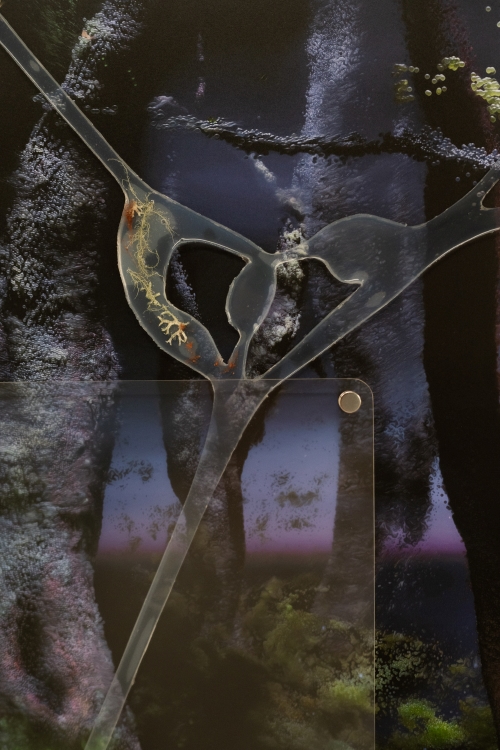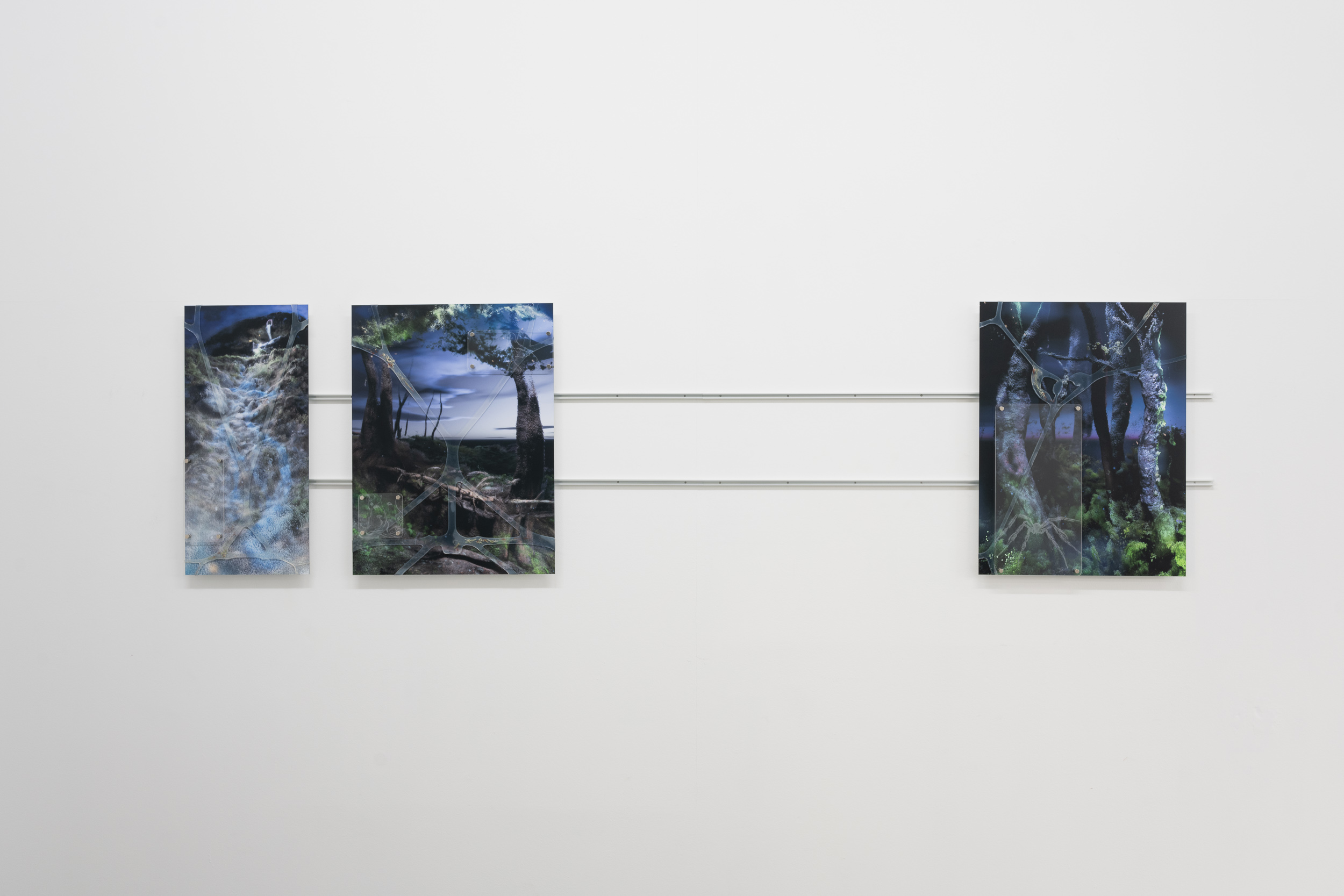Sunrise to Sunrise (Tricksters) 1 —7
2023 — ongoing
Mixed Media, Size Variable, UV Prints on Aludibond, Engraved Acrylic Glass, Magnets, Silicone, Engraved Aluminium Plates
Sunrise to Sunrise (Tricksters)
explores the dying of old worlds and practicing resistance through the creation of new memory– and dreamscapes. The work
unfolds its meaning by literally placing several layers of material on top of each other. Structurally distinct, these layers interconnect.
The rearmost layer of each of the three works consists of a print on an aluminum plate that, similar to Rooted Resurgence, shows organic material captured through 3D-scans. The point clouds in Sunrise to Sunrise (Tricksters) originate from cacao plantations in Ghana and the Carinthian Karawanks. Whereas renderings of fields and trees from plantation sites reference the colonialism, deforestation and climate crisis tied to Ghanaian agriculture, the latter, marking the border between Austria and Slovenia, is a historic site of Partisan action in World War II. Opoku seeks to build landscapes that embody resistance or elements from her memory and dreams: re-ownership and self-empowerment of the oppressed are set into a dialogue with antifascist movements of the past. With delicate materiality and the particularizing effect of the 3D-scans, Opoku’s landscapes seem so fragile, that they threaten to disintegrate at any moment. Utilizing an app for LiDAR 3D-scanning, originally developed for constructional engineering, Opoku’s point clouds never fully materialize. As the app’s algorithm cannot mesh them into 3D- models, the point clouds remain in a state of constant pending. Hence the works themselves foreshadow the hypothetical nature of their shown sceneries. These imaginary worlds are upheld only by the layers that superimpose them.
The rearmost layer of each of the three works consists of a print on an aluminum plate that, similar to Rooted Resurgence, shows organic material captured through 3D-scans. The point clouds in Sunrise to Sunrise (Tricksters) originate from cacao plantations in Ghana and the Carinthian Karawanks. Whereas renderings of fields and trees from plantation sites reference the colonialism, deforestation and climate crisis tied to Ghanaian agriculture, the latter, marking the border between Austria and Slovenia, is a historic site of Partisan action in World War II. Opoku seeks to build landscapes that embody resistance or elements from her memory and dreams: re-ownership and self-empowerment of the oppressed are set into a dialogue with antifascist movements of the past. With delicate materiality and the particularizing effect of the 3D-scans, Opoku’s landscapes seem so fragile, that they threaten to disintegrate at any moment. Utilizing an app for LiDAR 3D-scanning, originally developed for constructional engineering, Opoku’s point clouds never fully materialize. As the app’s algorithm cannot mesh them into 3D- models, the point clouds remain in a state of constant pending. Hence the works themselves foreshadow the hypothetical nature of their shown sceneries. These imaginary worlds are upheld only by the layers that superimpose them.
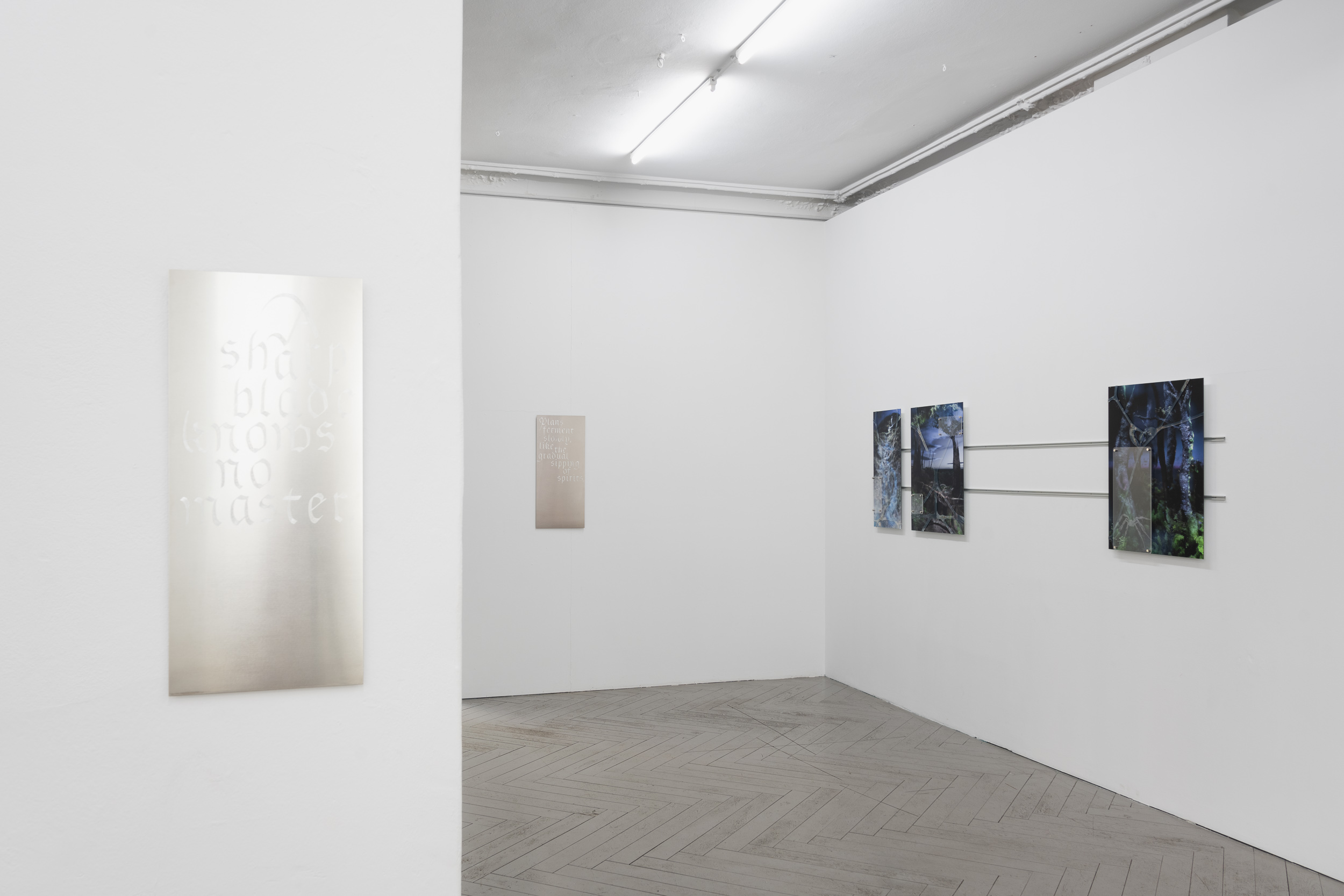 Exhibition views EIGEN+ART Lab, Berlin
Exhibition views EIGEN+ART Lab, BerlinCredits: Peter Oliver Wolff
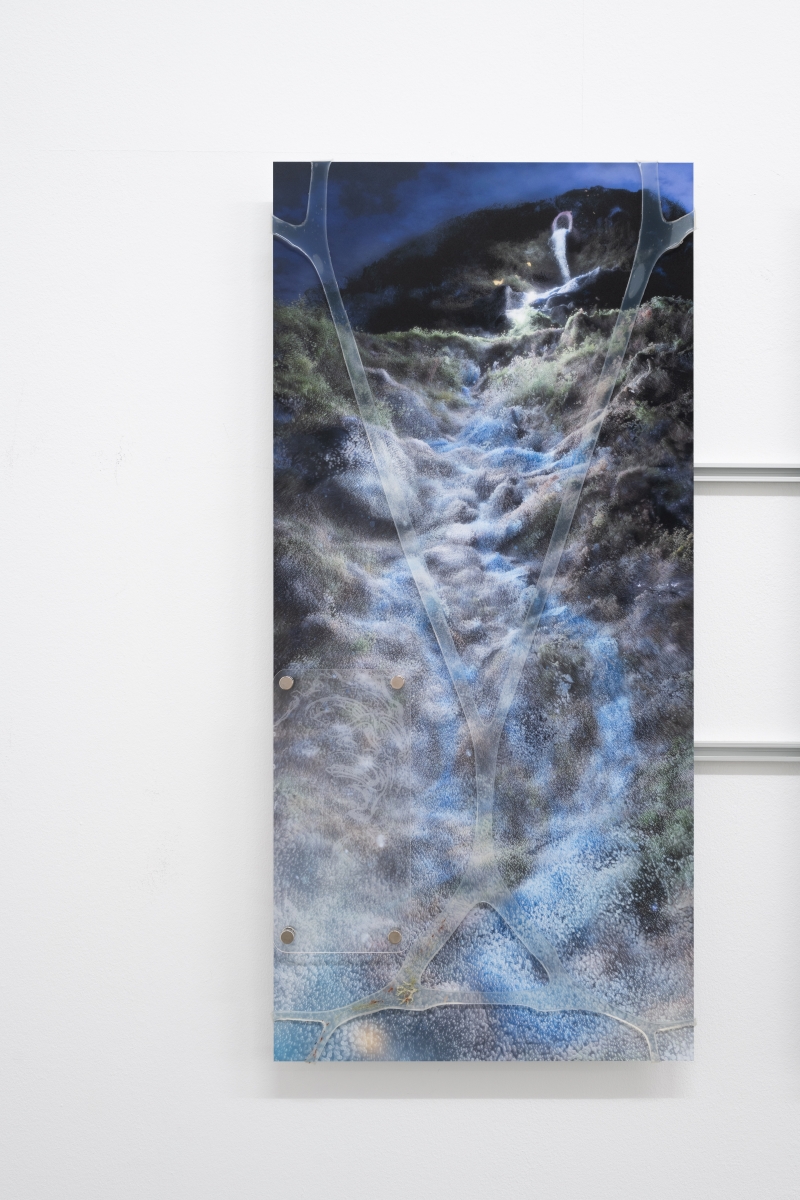

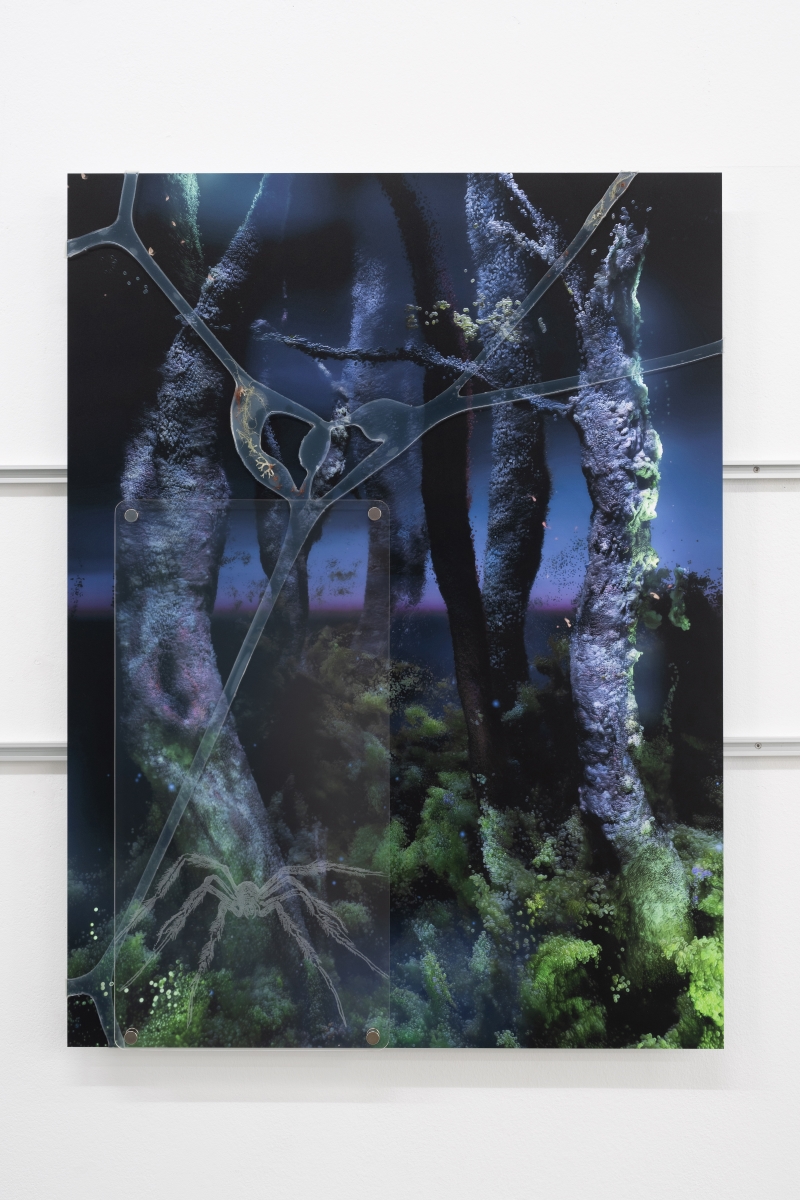
A filigree silicone layer serves as a frame, although it can hardly be understood as such. Stretched over the surface and around the images‘ edges this layer almost resembles a symbiotic organism. Small particles embedded in the silicone layer originate from sites scanned by Opoku – these are the only actual organic and inorganic materials present in her work. The silicone mold’s pattern, generated and cast with the help of AI tools, derives from Adinkra symbols. In Ghanaian and Akan culture, Adinkra symbols hold historical and philosophical meaning, conveying aphorisms and allegorical concepts. While these visual symbols are traditionally used on pottery and textiles, Opoku trained an AI with a data set to build her own Adinkra. In yet another piece of the series Sunrise to Sunrise (Tricksters), Opoku imparts a linguistic expression to the Adinkra symbols: Engravings, written also on aluminum plates, feature proverbs from the same data used for creating the silicone layer. Opoku leaves it to the audience to envision the landscape counterparts to these tenets. Utilizing AI to create new images and meaning, the artist references how cultural symbolisms, like the Adinkra and Tricksters, undergo transformations influenced by various factors, especially within the context of temporization. By incorporating aspects of generational knowledge, the dynamics of migration processes, and the enduring effects of the diasporic experience, Opoku’s works transcend the mere act of appropriating mysticism, history, and culture. Instead, they explore the intricate alterations and enhancement of culturally significant concepts, deeply interwoven with the essence of temporal progression.
Acrylic glass plates attached with magnets try to preserve the sceneries by partially sealing them off. Figurative engravings placed on the glass complement the landscapes and particles. Among other figures from Akan mythology, Anansi, portrayed as a spider, is one of the tricksters reinterpreted by Opoku for her series. Like a protagonist, the spider enlivens the digitally created forest, becoming the depiction of an ancestor, a guiding spirit representing agency. The tricksters in mythology inhabit a realm of ambivalence. They defy norms using intellect and wit, and navigate through obstacles and gray areas employing inventive solutions. It is precisely this pursuit of non-conformity that relates the figure of the trickster to the notion of resistance. In the Akan folklore tales, Anansi, known as the god of knowledge, stories, wisdom and trickery, poses as such a character by challenging the power- by-strength narrative with his cunning. According to Creole oral lore, Anansi even survives apocalypses and the transatlantic slave trade.
However, the single components of Sunrise to Sunrise (Tricksters) are neither static in construction nor division. The series is expandable, allowing its layers to interchange.
Excerpt from the press release by Naomi Rado for EIGEN+ART Lab.
